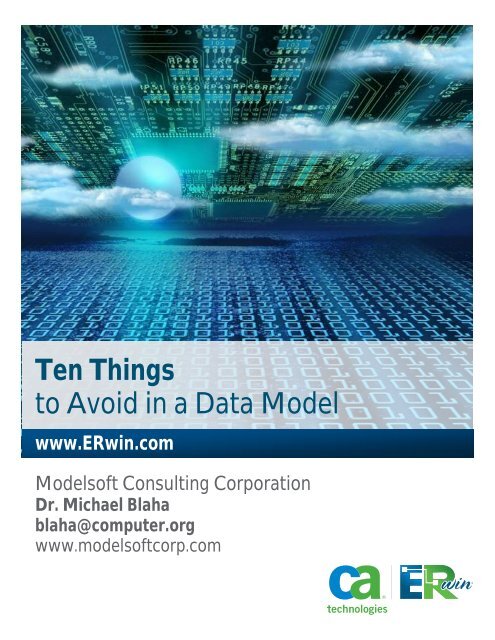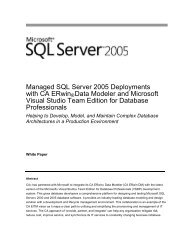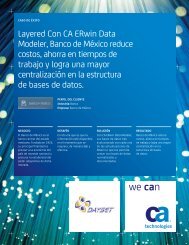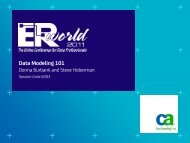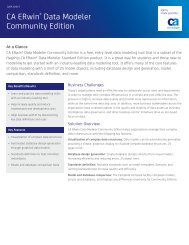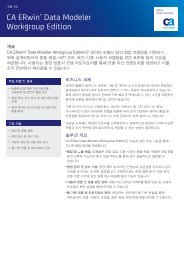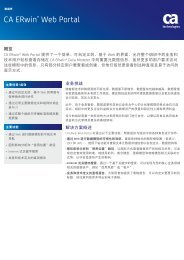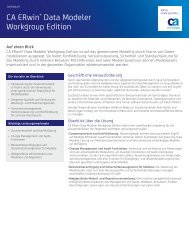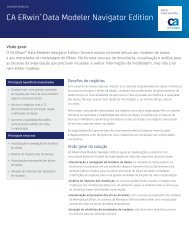Ten Things to Avoid in a Data Model - CA ERwin
Ten Things to Avoid in a Data Model - CA ERwin
Ten Things to Avoid in a Data Model - CA ERwin
Create successful ePaper yourself
Turn your PDF publications into a flip-book with our unique Google optimized e-Paper software.
<strong>Ten</strong> <strong>Th<strong>in</strong>gs</strong><strong>to</strong> <strong>Avoid</strong> <strong>in</strong> a <strong>Data</strong> <strong>Model</strong>www.ERw<strong>in</strong>.com<strong>Model</strong>soft Consult<strong>in</strong>g CorporationDr. Michael Blahablaha@computer.orgwww.modelsoftcorp.com
<strong>Ten</strong> <strong>Th<strong>in</strong>gs</strong> <strong>to</strong> <strong>Avoid</strong> <strong>in</strong> a <strong>Data</strong> <strong>Model</strong>AbstractA data model helps developers th<strong>in</strong>k deeply about a database and cope withlarge size and complexity. However, given their high level of abstraction,data models can be difficult <strong>to</strong> construct and prone <strong>to</strong> errors. This articleprovides a checklist of some mistakes you should be sure <strong>to</strong> avoid,thereby improv<strong>in</strong>g the quality of your data models.IntroductionA model is an abstraction of some aspect of a problem [1]. A data modelis a model that describes how data is represented and accessed, usuallyfor a database. The construction of a data model is one of the moredifficult tasks of software eng<strong>in</strong>eer<strong>in</strong>g and is often pivotal <strong>to</strong> the successor failure of a project.Many fac<strong>to</strong>rs determ<strong>in</strong>e the effectiveness of a data model [4] [6] — <strong>to</strong>omany <strong>to</strong> fully address here. Instead we discuss pitfalls that developers canoverlook. By avoid<strong>in</strong>g these pitfalls, you can improve your models.Our focus is not on detailed model<strong>in</strong>g constructs such as keys, data types,nullability, and referential <strong>in</strong>tegrity. Rather we emphasize the deeperessential content of a model.<strong>Th<strong>in</strong>gs</strong> <strong>to</strong> <strong>Avoid</strong> –<strong>Model</strong><strong>in</strong>g Strategy<strong>Ten</strong> <strong>Th<strong>in</strong>gs</strong><strong>to</strong> <strong>Avoid</strong> <strong>in</strong> <strong>Data</strong> <strong>Model</strong><strong>Th<strong>in</strong>gs</strong> <strong>to</strong> <strong>Avoid</strong> – <strong>Model</strong><strong>in</strong>g Strategy1. Vague Purpose2. Literal <strong>Model</strong><strong>in</strong>g3. Large Size4. Speculative Content5. Lack of Clarity<strong>Th<strong>in</strong>gs</strong> <strong>to</strong> <strong>Avoid</strong> – <strong>Model</strong><strong>in</strong>g Details6. Reckless Violation of Normal Forms7. Needless Redundancy8. Parallel Attributes9. Symmetric Relationships10. Anonymous FieldsHere are five high-level items <strong>to</strong> avoid.1Vague PurposeDon’t build a model without understand<strong>in</strong>g the bus<strong>in</strong>ess rationale. The purpose for a model dictates the level of detail (just entities andrelationships, fully attributed, with data types and full constra<strong>in</strong>ts). The purpose also dictates the level of polish, the degree ofcompleteness, and the amount of time that can be justified.There are different k<strong>in</strong>ds of data models. A detailed application model is needed <strong>to</strong> guide application development. A rough applicationmodel suffices for convey<strong>in</strong>g purchase requirements <strong>to</strong> a vendor. An enterprise model reaches across applications enabl<strong>in</strong>g <strong>in</strong>tegration,data warehouses, and other broad activities.2Literal <strong>Model</strong><strong>in</strong>gAs a modeler, your job is not <strong>to</strong> do what the cus<strong>to</strong>mer literally says — you won’t get credit for follow<strong>in</strong>g <strong>in</strong>structions if the project fails.Rather your role is <strong>to</strong> solve the problem that the cus<strong>to</strong>mer is imperfectly describ<strong>in</strong>g. Therefore, you must pay attention <strong>to</strong> the hiddentrue requirements. You must <strong>in</strong>terpret and abstract what the cus<strong>to</strong>mer tells you.We are sensitized <strong>to</strong> the trap of literal model<strong>in</strong>g by development with use cases. (A use case is a piece of cus<strong>to</strong>mer-specifiedfunctionality for a system.) Many developers record use cases, while never th<strong>in</strong>k<strong>in</strong>g deeply about their content. Developers can fall <strong>in</strong><strong>to</strong>the trap of slavishly build<strong>in</strong>g exactly what the cus<strong>to</strong>mer describes.The alternative <strong>to</strong> literal model<strong>in</strong>g is thoughtful model<strong>in</strong>g with abstraction. There can be different ways of satisfy<strong>in</strong>g cus<strong>to</strong>mer needs. Inparticular, you must recognize arbitrary bus<strong>in</strong>ess decisions that could easily change. Often you can avoid such vulnerability byPAGE 2www.ERw<strong>in</strong>.com
<strong>Ten</strong> <strong>Th<strong>in</strong>gs</strong> <strong>to</strong> <strong>Avoid</strong> <strong>in</strong> a <strong>Data</strong> <strong>Model</strong>abstract<strong>in</strong>g a model a bit.For example, we encountered an application with separate tables for IndividualContribu<strong>to</strong>r, Supervisor, and Manager.IndividualContribu<strong>to</strong>rs report <strong>to</strong> Supervisors and Supervisors report <strong>to</strong> Managers. This model is correct, but has problems. There is muchcommonality between the tables—for example, all three have phone numbers and addresses. The only difference is the report<strong>in</strong>ghierarchy.Figure 1 shows an excerpt of the orig<strong>in</strong>al model and an improved model that is more abstract. Instead of “hard cod<strong>in</strong>g” themanagement hierarchy, we can “soft code” it with a boss relationship. A person who has an employeeType of “IndividualContribu<strong>to</strong>r”reports <strong>to</strong> another person with an employeeType of “Supervisor.” Similarly, a supervisor reports <strong>to</strong> a manager. A worker has an optionalboss, so the report<strong>in</strong>g hierarchy eventually s<strong>to</strong>ps. The improved model is smaller and more flexible.You can also raise abstraction is by th<strong>in</strong>k<strong>in</strong>g <strong>in</strong> terms of patterns [1]. A pattern is a model fragment that is profound and recurr<strong>in</strong>g. Apattern distills the knowledge of experts and provides a proven solution <strong>to</strong> a general problem. Patterns also boost productivity <strong>in</strong>build<strong>in</strong>g models.Orig<strong>in</strong>al literal modelImproved model that is more abstractFigure 1 – Don’t fall <strong>in</strong> the trap of literal model<strong>in</strong>g. Use abstraction <strong>to</strong> <strong>in</strong>crease bus<strong>in</strong>ess flexibility.Chapter 12 of [4] presents the <strong>Data</strong> <strong>Model</strong> Scorecard®. Scorecard item 5 (how well does the model leverage generic structures)corresponds <strong>to</strong> our warn<strong>in</strong>g about literal model<strong>in</strong>g.3Large SizeOver the years we have learned <strong>to</strong> avoid large models. As a general rule, you should try <strong>to</strong> limit a model <strong>to</strong> no more than 200 tables. Thereason is that large models <strong>in</strong>volve more work. You must ask yourself if the large size is really justified or if you can simplify the modelthrough some well-placed abstraction. In our consult<strong>in</strong>g work, we often reverse eng<strong>in</strong>eer exist<strong>in</strong>g databases. We rarely f<strong>in</strong>d a largemodel with a compell<strong>in</strong>g justification.Reference [2] illustrates the downsides of large models. For a data <strong>in</strong>terchange project, we built an equipment data model that was 100pages long. Equipment has a wide and deep taxonomy and we documented the details for the many different types. Figure 2 shows avery small excerpt. In retrospect we should have used an abstract model that def<strong>in</strong>ed types of equipment and their attributes withmetadata.When I build models, I now have an explicit step <strong>to</strong> reconsider the model’s size. Is there extraneous content that I can remove? Can Ishift the representation and make a model more concise and adaptable? How much work is it <strong>to</strong> develop the application for the modeland is it worthwhile from a bus<strong>in</strong>ess perspective?You should organize models with more than 50 tables <strong>in</strong><strong>to</strong> subject areas. A subject area is a group of elements (entity types,relationships, generalizations, and lesser subject areas) with a common theme. Subject areas help readers understand portions of amodel at a time, rather than hav<strong>in</strong>g <strong>to</strong> deal with the whole model at once.PAGE 3www.ERw<strong>in</strong>.com
<strong>Ten</strong> <strong>Th<strong>in</strong>gs</strong> <strong>to</strong> <strong>Avoid</strong> <strong>in</strong> a <strong>Data</strong> <strong>Model</strong>Figure 2 – Try <strong>to</strong> avoid large models. A shift <strong>in</strong> representation can often lead <strong>to</strong> amore concise and effective model.4Speculative ContentIt is not a good idea <strong>to</strong> <strong>in</strong>clude content that is not needed now and “might be helpful” <strong>in</strong> the future. All this does is <strong>to</strong> make a modellarger, <strong>in</strong>crease development time, and raise cost. A model must fully address the requirements, but not greatly exceed them. At least90 percent of a model should perta<strong>in</strong> <strong>to</strong> immediate needs. As much as 10 percent can anticipate future needs. Otherwise you run therisk of scope creep.Aside from size and cost, another reason for limit<strong>in</strong>g speculative content is that a quality data model should be <strong>in</strong>tr<strong>in</strong>sically sound andreadily extended. New requirements should cause additions, but little alteration. The addition of 10 percent <strong>to</strong> a model, should causerework of no more than 10 percent of the orig<strong>in</strong>al model. If you can readily extend a model, there is no po<strong>in</strong>t <strong>to</strong> add<strong>in</strong>g content <strong>in</strong>advance of need. When you really need more content, the new requirements will be clearer than if you try <strong>to</strong> forecast them <strong>in</strong> advance.Keep <strong>in</strong> m<strong>in</strong>d that the purpose of model<strong>in</strong>g is <strong>to</strong> represent data relevant <strong>to</strong> your bus<strong>in</strong>ess objectives. Some people lose focus and modelextraneous <strong>in</strong>formation. It can be reasonable <strong>to</strong> model a bit beyond your needs—after all, the exact scope of an application is seldomknown up front and is partially a matter of negotiation. However, you do not want <strong>to</strong> reach way beyond application needs, becausesuch a model is speculative and may never lead <strong>to</strong> someth<strong>in</strong>g useful.In [4] the <strong>Data</strong> <strong>Model</strong> Scorecard® item 3 (how complete is the model) corresponds <strong>to</strong> limit speculative content.PAGE 4www.ERw<strong>in</strong>.com
<strong>Ten</strong> <strong>Th<strong>in</strong>gs</strong> <strong>to</strong> <strong>Avoid</strong> <strong>in</strong> a <strong>Data</strong> <strong>Model</strong>5 Lack of ClarityNormally a model should be free of obfuscation. (A model of a secure military application could be an exception.) A relational databaseis declarative and your model should adhere <strong>to</strong> the same spirit. So declare data <strong>in</strong> your models.ERw<strong>in</strong> has a nice feature where you can def<strong>in</strong>e doma<strong>in</strong>s. A doma<strong>in</strong> is the set of possible values for an attribute. You def<strong>in</strong>e the doma<strong>in</strong>sfor your application and then assign them <strong>to</strong> the pert<strong>in</strong>ent attributes. For example an application may have attributes cus<strong>to</strong>merName,projectName, and productName that can be assigned the name doma<strong>in</strong>. Then they have a consistent data type and length that isdef<strong>in</strong>ed <strong>in</strong> one place.Enumerations are a special k<strong>in</strong>d of doma<strong>in</strong>. An enumeration is a doma<strong>in</strong> that has a f<strong>in</strong>ite set of values. For example, a car may have acolor that can be red, green, or blue. Do not def<strong>in</strong>e enumerations <strong>in</strong> programm<strong>in</strong>g code and s<strong>to</strong>re the encod<strong>in</strong>g <strong>in</strong> the database. Insteaddeclare enumerations <strong>in</strong> your database. Enumerations often arise <strong>in</strong> applications. They appear <strong>in</strong> user <strong>in</strong>terfaces as pick lists. Bus<strong>in</strong>essexperts often mention enumerated values when describ<strong>in</strong>g an application.As Figure 3 shows, enumerations may be declared or encoded. Declared enumerations are s<strong>to</strong>red as a str<strong>in</strong>g <strong>in</strong> place or <strong>in</strong> a separatetable (either is reasonable). Encoded enumerations are s<strong>to</strong>red as a number which application code must translate (this is undesirable).Doma<strong>in</strong>s and enumerations are just two aspects of declar<strong>in</strong>g data. In addition, don’t s<strong>to</strong>re data structures with a b<strong>in</strong>ary encod<strong>in</strong>g. Don’tuse cryptic names. Don’t use anonymous fields that application code must <strong>in</strong>terpret.Car tablecarID year color weight123200119892000redredblue200015002500Enumeration s<strong>to</strong>red <strong>in</strong> placeCar tablecarID year colorID weight123200119892000Color tablecolorID123color113redgreenblue200015002500Enumeration s<strong>to</strong>red separately123Car tablecarID year color weight200119892000113200015002500Enumeration encoded (AVOID)Figure 3 – A model should have clarity. Declare data, such as enumerations, <strong>in</strong> your models.<strong>Th<strong>in</strong>gs</strong> <strong>to</strong> <strong>Avoid</strong> – <strong>Model</strong><strong>in</strong>g DetailsHere are another five th<strong>in</strong>gs <strong>to</strong> avoid, this time look<strong>in</strong>g at models <strong>in</strong> detail.Some of our detailed advice varies for operational and analytical applications. An operational application (such as an order entrysystem) concerns the rout<strong>in</strong>e operations of a bus<strong>in</strong>ess. Operational activities tend <strong>to</strong> be simple, access few records, and respond with<strong>in</strong>seconds.In contrast, analytical applications emphasize complex queries that read large quantities of data and enable organizations <strong>to</strong> makestrategic decisions. Analytical applications execute aga<strong>in</strong>st a data warehouse. <strong>Data</strong> warehouses are skewed <strong>to</strong>wards read<strong>in</strong>g and theirstructure does not enforce data quality — that is the job of the load<strong>in</strong>g programs. Thus some of the detailed model<strong>in</strong>g anomalies areacceptable for data warehouse applications.PAGE 5www.ERw<strong>in</strong>.com
<strong>Ten</strong> <strong>Th<strong>in</strong>gs</strong> <strong>to</strong> <strong>Avoid</strong> <strong>in</strong> a <strong>Data</strong> <strong>Model</strong>6 Reckless Violation of Normal FormsA normal form is a guidel<strong>in</strong>e for relational database design that <strong>in</strong>creases data consistency [3]. As tables satisfy higher levels of normalforms, they are less likely <strong>to</strong> s<strong>to</strong>re redundant or contradic<strong>to</strong>ry data. Normal forms are not fiat rules. Developers can violate them forgood cause, such as <strong>to</strong> <strong>in</strong>crease performance for a bottleneck, such as tables that are read and seldom updated. Such a relaxation iscalled denormalization. The important issue with normal forms is <strong>to</strong> violate them deliberately and only when necessary.Figure 4 shows an example of a denormalized table and the normalized restatement. The contact position and contact phone dependon the contact name which <strong>in</strong> turn depends on the primary key of the table. Such <strong>in</strong>direct dependencies violate third normal form.Several cus<strong>to</strong>mer records could have the same contact person as <strong>in</strong>dicated by contact name. The problem with the current design isthat the various references <strong>to</strong> a contact need not have the same position and phone. A separate contact table can enforce uniformity ofposition and phone.Violates normal formSatisfies normal formFigure 4 – Do not violate normal forms, except for analytical applicationsand performance bottlenecks.Denormalization is only justified for operational applications when there is a major performance bottleneck. In contrast,denormalization is rout<strong>in</strong>e practice for analytical applications because it simplifies queries. The negative effects on data quality areunimportant as a data warehouse relies on the load<strong>in</strong>g programs for data quality.Pay attention <strong>to</strong> large tables <strong>in</strong> operational applications as the large size may <strong>in</strong>dicate denormalization. A ‘large’ table has 30 attributesor more.Denormalization is often caused by mix<strong>in</strong>g entity types. So you should suspect any entity type that is difficult <strong>to</strong> def<strong>in</strong>e. An entity typeshould be simple and coherent. Otherwise, unless you have a situation where denormalization is justified, you should split a compositeentity type <strong>in</strong><strong>to</strong> its fundamental constituents.7Needless RedundancyObserv<strong>in</strong>g normal forms alone is not sufficient — the larger issue is avoid<strong>in</strong>g needless redundancy. The violation of normal forms isundesirable precisely because it causes redundancy. Ideally a database should have a s<strong>in</strong>gle record<strong>in</strong>g of each data item.Redundancy is a plague of <strong>in</strong>formation systems. Organizations are rife with applications that overlap <strong>in</strong> awkward and loosely controlledways. In fact, one of the major justifications for data warehouses is hav<strong>in</strong>g a report<strong>in</strong>g system that reconciles conflict<strong>in</strong>g data [5].Redundant data is seldom helpful. Don’t <strong>in</strong>clude redundant data <strong>in</strong> an attempt <strong>to</strong> compensate for a poorly conceived application.Relational databases can deliver surpris<strong>in</strong>gly good performance if an application is properly architected. It is difficult <strong>to</strong> keep redundantdata consistent with the base data. There are issues of the latency of update, vulnerability <strong>to</strong> errors, and additional code <strong>to</strong> write.Redundant data is more acceptable if you use built-<strong>in</strong> database features <strong>to</strong> keep redundant data consistent with base data. Forexample, materialized views can be helpful.PAGE 6www.ERw<strong>in</strong>.com
<strong>Ten</strong> <strong>Th<strong>in</strong>gs</strong> <strong>to</strong> <strong>Avoid</strong> <strong>in</strong> a <strong>Data</strong> <strong>Model</strong>8 Parallel AttributesFigure 5 illustrates parallel attributes. The left table has one record per project and s<strong>to</strong>res <strong>in</strong>dividual project costs with parallelattributes.In contrast, the right tables treat cost symmetrically; n<strong>in</strong>e records s<strong>to</strong>re a project’s cost data. CostItem is material, labor, or tax.CostBasis is estimate, reestimate, or actual. The two estimates are an artifact of the exist<strong>in</strong>g bus<strong>in</strong>ess process and could change. In thefuture, there could be one estimate or three estimates. Furthermore, there could be additional CostItems. The parameterized modelpreserves flexibility by not encod<strong>in</strong>g such arbitrary bus<strong>in</strong>ess practices <strong>in</strong><strong>to</strong> the database structure.Parallel attributes are acceptable for a data warehouse and are often used <strong>in</strong> dimensions <strong>to</strong> simplify queries. For operationalapplications, a few parallel attributes are <strong>in</strong>offensive, but widespread use often <strong>in</strong>dicates a poor model.Parallel attributesParameterized modelFigure 5 – <strong>Avoid</strong> parallel attributes for non-data-warehouse applications.9Symmetric RelationshipsSymmetric relationships are troublesome for relational databases. Resolve them by promot<strong>in</strong>g the relationship <strong>to</strong> an entity type. Theimproved model not only resolves the symmetry but is often more expressive.In the left model of Figure 6 RelatedContract is a many-<strong>to</strong>-many relationship. If each pair<strong>in</strong>g is entered once, it is not clear whichcontract should be first and which is second. If each pair<strong>in</strong>g is entered twice, the amount of s<strong>to</strong>rage <strong>in</strong>creases and any change requiresdouble update. If more than two contracts are related, the situation is messier yet (for three contracts that are double s<strong>to</strong>red: C1-C2, C2-C1, C1-C3, C3-C1, C2-C3, C3-C2). Furthermore, there is no requirement that the related contracts be different. None of this is desirable.Symmetric relationship (AVOID)Symmetric relationship promoted <strong>to</strong> an entity typeFigure 6 – Promote a symmetric relationship <strong>to</strong> an entity type <strong>in</strong> its own right.The improved model (right of Figure 6) breaks the symmetry. To f<strong>in</strong>d related contracts traverse as follows: start with a Contract, f<strong>in</strong>d thepossible ContractRelationship, then traverse back <strong>to</strong> Contract (exclud<strong>in</strong>g the <strong>in</strong>itial contract) <strong>to</strong> obta<strong>in</strong> the related Contracts.PAGE 7www.ERw<strong>in</strong>.com
<strong>Ten</strong> <strong>Th<strong>in</strong>gs</strong> <strong>to</strong> <strong>Avoid</strong> <strong>in</strong> a <strong>Data</strong> <strong>Model</strong>The revised model has further advantages. The coupl<strong>in</strong>g is no longer b<strong>in</strong>ary and can readily support three or more related contracts. Themodel could be extended <strong>to</strong> make Contract <strong>to</strong> ContractRelationship many-<strong>to</strong>-many with different relationship types. For example, onerelationship type could be successor contracts (one contract replac<strong>in</strong>g another). A second relationship type could be alternativecontracts (several contracts be<strong>in</strong>g considered as alternatives for purchase).10Anonymous FieldsAs much as possible, you should clearly describe the data be<strong>in</strong>g s<strong>to</strong>red and not use anonymous fields.Figure 7 shows an excerpt of a location table with anonymous fields. To f<strong>in</strong>d a city, you must search multiple fields. Worse yet, it couldbe difficult <strong>to</strong> dist<strong>in</strong>guish the city of Chicago from Chicago street. Furthermore, you may need <strong>to</strong> parse a field <strong>to</strong> separate city, state, andpostal code. It would be much better <strong>to</strong> put address <strong>in</strong>formation <strong>in</strong> dist<strong>in</strong>ct fields that are clearly named.ConclusionFigure 7 – Don’t use the poor design practice of anonymous fields.<strong>Data</strong> model<strong>in</strong>g is often the pivotal task <strong>in</strong> build<strong>in</strong>g a database application. A data model determ<strong>in</strong>es an application’s data quality,extensibility, and performance — and ultimately whether or not the application has a chance at bus<strong>in</strong>ess success. Many fac<strong>to</strong>rsdeterm<strong>in</strong>e the effectiveness of a data model. We present some of the possible pitfalls here, both from the perspective of model<strong>in</strong>gstrategy as well as model<strong>in</strong>g detail. By avoid<strong>in</strong>g these pitfalls, you can improve your data models.Referencesfragment of Location tablelocationAddress1 locationAddress2 locationAddress3456 Chicago Street198 Broadway Dr.123 Ma<strong>in</strong> StreetChicago, IL xxxxxDecatur, IL xxxxxSuite 201Cairo, IL xxxxx1. Michael Blaha. Patterns of <strong>Data</strong> <strong>Model</strong><strong>in</strong>g. New York, NY: CRC Press, 2010.2. Michael Blaha. <strong>Data</strong> s<strong>to</strong>re models are different than data <strong>in</strong>terchange models. ateM workshop, 10th IEEE Work<strong>in</strong>g Conference onReverse Eng<strong>in</strong>eer<strong>in</strong>g, November 2003, Vic<strong>to</strong>ria, BC.3. Ramez Elmasri and Shamkant B. Navathe. Fundamentals of <strong>Data</strong>base Systems, 6th edition. Read<strong>in</strong>g, Massachusetts: Addison-Wesley,2010.4. Steve Hoberman. <strong>Data</strong> <strong>Model</strong><strong>in</strong>g Made Simple, 2nd edition. Bradley Beach, NJ: Technics Publications, 2009.5. W. H. Inmon. Build<strong>in</strong>g the <strong>Data</strong> Warehouse, 4th edition. New York; Wiley, 2005.Chicago, IL xxxxx6. Graeme C. Simsion and Graham C. Witt. <strong>Data</strong> <strong>Model</strong><strong>in</strong>g Essentials, 3rd edition. San Francisco, <strong>CA</strong>: Morgan Kaufmann, 2005.BiographyS<strong>in</strong>ce 1994 Dr. Michael Blaha has been a consultant and tra<strong>in</strong>er <strong>in</strong> conceiv<strong>in</strong>g, architect<strong>in</strong>g, model<strong>in</strong>g, design<strong>in</strong>g, and tun<strong>in</strong>g databasesfor dozens of organizations throughout the world. He has authored six U.S. patents, five widely used books, and many papers. His mostrecent book, Patterns of <strong>Data</strong> <strong>Model</strong><strong>in</strong>g, was published <strong>in</strong> June 2010. Blaha received his doc<strong>to</strong>rate from Wash<strong>in</strong>g<strong>to</strong>n University <strong>in</strong> St.Louis and is an alumnus of GE Global Research <strong>in</strong> Schenectady, NY. You can contact him at blaha@computer.org.PAGE 8www.ERw<strong>in</strong>.com


